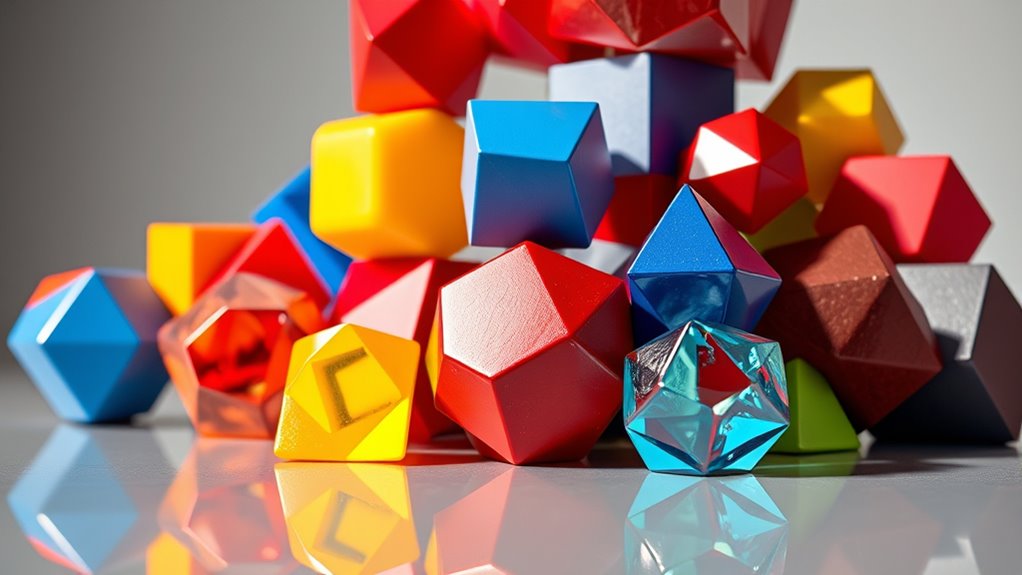Polygons and polyhedra are the fundamental building blocks of 2D and 3D shapes. Polygons are figures with straight sides that form closed shapes, like triangles and squares, classified by their sides and angles. Polyhedra are 3D shapes with flat faces, such as cubes and pyramids. Understanding their properties helps you recognize how shapes are constructed and used in architecture, design, and beyond. Exploring further reveals how these shapes influence structures and visualizations around you.
Key Takeaways
- Polygons are closed 2D shapes with straight sides, serving as fundamental building blocks for flat geometric designs.
- Polyhedra are three-dimensional shapes composed of polygonal faces, forming the core of 3D geometric structures.
- Both polygons and polyhedra are classified by their sides, angles, faces, and symmetry properties, essential for understanding shape geometry.
- Regular polygons and polyhedra exhibit equal sides and angles, providing balanced, symmetrical building blocks in design and architecture.
- Visualizing nets and models of polygons and polyhedra helps comprehend their structure, relationships, and applications in various fields.
What Are Polygons and How Are They Classified?

Have you ever wondered what exactly makes a shape a polygon? It all comes down to specific polygon properties. A polygon is a closed, two-dimensional shape with straight sides. The number of sides and their arrangement help classify polygons into different types, like triangles, quadrilaterals, or pentagons. Shape classification depends on these properties—whether the sides are equal, the angles are right, or if the sides are parallel. Regular polygons have equal sides and angles, while irregular ones don’t. Understanding polygon properties makes it easier to identify and categorize shapes. Fundamentally, a polygon’s defining features set it apart from other shapes, helping you recognize and analyze them in both simple and complex forms. Additionally, the classification of polygons relies heavily on their geometric properties, which are essential for distinguishing between different types.
Exploring the Properties of Polygons

What makes a polygon unique are its defining properties that distinguish it from other shapes. These include the number of sides, angles, and the ability to tessellate, creating endless patterns. Polygon symmetry reveals how shapes can be divided into mirror images, adding beauty and harmony. Recognizing these properties helps you see how polygons fit together in tessellations and design. Here’s a quick look at some properties:
| Property | Description | Example |
|---|---|---|
| Sides | Number of edges | Triangle, Pentagon |
| Angles | Interior and exterior angles | Equal or varied angles |
| Tessellations | How polygons tile a plane | Hexagons in honeycombs |
| Symmetry | Mirror and rotational symmetry | Regular squares and stars |
| Convex/Concave | Shape’s bulge or indentations | Convex polygons are outward, concave have indentations |
Understanding these properties reveals the elegance of polygons and their role in pattern building. Additionally, the ability to tessellate showcases how polygons can seamlessly tile a surface, which is fundamental in both art and architecture.
Types of Polygons Based on Sides and Angles

Now, you’ll see how polygons can be classified by their sides and angles. You can identify regular shapes with equal sides and angles, or irregular ones that don’t. You’ll also recognize convex polygons that bulge outward and concave ones with indentations, based on their number of sides and angles.
Regular vs. Irregular Shapes
Polygons can be classified as either regular or irregular based on their sides and angles. Regular polygons have all sides equal and angles equal, creating symmetrical, balanced shapes often used in artistic patterns and design. These shapes symbolize harmony and stability, making them popular in logos and decorative motifs. Irregular polygons, on the other hand, have sides and angles that vary, resulting in asymmetrical forms. They add visual interest and uniqueness to artwork and architecture. Recognizing whether a shape is regular or irregular helps you understand its structure and potential symbolism. Regular shapes often evoke order and perfection, while irregular ones can express creativity and spontaneity. Both types enrich your understanding of shape symbolism and their applications in art and design.
Convex vs. Concave Forms
Convex and concave forms are important ways to classify polygons based on their angles and sides. A convex polygon’s interior angles are all less than 180 degrees, and no line segment between two points on the shape crosses outside it. This makes convex polygons ideal for polygon tessellations, where shapes fit together without gaps. In contrast, concave polygons have at least one interior angle greater than 180 degrees, creating indentations. These indentations make concave shapes less suitable for tessellations but interesting in polyhedral nets, where 2D shapes fold into 3D forms. Recognizing whether a shape is convex or concave helps you understand its properties and how it can be used as a building block in both 2D and 3D structures.
Number of Sides and Angles
Shapes are classified by their number of sides and angles, which directly influence their properties and how they can be used. For example, triangles and quadrilaterals have different potential for polygon tessellation, creating seamless patterns. The number of sides determines whether a polygon is regular or irregular, affecting symmetry operations like reflection, rotation, and translation. Regular polygons, with equal sides and angles, often exhibit rotational symmetry and are easier to tessellate. In contrast, irregular polygons may lack symmetry but can still tile a plane under specific conditions. Understanding the relationship between sides and angles helps you identify the types of polygons suited for various design and architectural applications. This classification also allows you to analyze how different shapes combine to fill spaces efficiently. Insights from geometric principles deepen comprehension of shape properties and their practical uses.
Understanding Polyhedra and Their Characteristics

Understanding polyhedra involves exploring their three-dimensional structure and the way their faces, edges, and vertices connect. You can visualize polyhedra using polyhedral nets, which unfold the surface into a flat shape, helping you see how faces come together. Each polyhedron has specific vertex configurations, describing how many faces meet at each vertex. Recognizing these patterns helps you identify different polyhedra and understand their properties. For example, some polyhedra have uniform vertex configurations, making them highly symmetrical. The connections between faces, edges, and vertices influence the shape’s stability and overall form. Studying these characteristics reveals the top rated heated mattress pads that are most effective and durable. By studying these characteristics, you gain insight into the structure and classification of polyhedra, forming a foundation for understanding more complex three-dimensional figures.
Common Types of Polyhedra in Geometry

You’ll find that some polyhedra, called Platonic solids, have highly regular shapes with identical faces and vertices. These shapes serve as perfect examples of symmetry and balance in geometry. Let’s look at common polyhedra like cubes, tetrahedra, and octahedra to understand their unique characteristics.
Platonic Solids Characteristics
Platonic solids are highly regular polyhedra characterized by identical faces composed of congruent regular polygons, with the same number of faces meeting at each vertex. These solids exemplify geometric perfection, where symmetry and uniformity define their structure. Each face is a perfect regular polygon, and all edges and angles are equal, creating a harmonious shape. There are only five Platonic solids: tetrahedron, cube, octahedron, dodecahedron, and icosahedron. Their regularity ensures that every vertex has the same configuration, reflecting a deep sense of balance and order. Because of their perfect symmetry, they’ve fascinated mathematicians and artists alike for centuries. These characteristics make Platonic solids fundamental examples of symmetry, regularity, and geometric excellence in 3D shapes. Understanding these structures highlights the importance of uniformity and harmony in geometric forms.
Common Polyhedron Examples
Polyhedra are three-dimensional shapes made up of flat polygonal faces, straight edges, and vertices. Among the common polyhedron examples, the cube is familiar for its six square faces and equal edges. The pyramid features a polygon base with triangular faces meeting at a single vertex. The dodecahedron has twelve pentagonal faces, often seen in polyhedron volume calculations. Many polyhedra can be part of polygon tessellations, creating intricate patterns on surfaces. The shape and number of faces influence a polyhedron’s volume and stability. Recognizing these examples helps you visualize how polyhedra are used in architecture, design, and modeling. Essential oils are sometimes used in designing models of polyhedra for educational purposes, illustrating how different faces and vertices interact.
The Relationship Between Shapes and Their Dimensions

Understanding how shapes relate to their dimensions is essential in geometry because it reveals the fundamental properties that distinguish one shape from another. When you analyze dimensions, you see how shapes change through shape transformations like scaling, rotating, or translating. Dimension analysis helps you understand why a triangle is different from a square or a cube from a sphere. Shapes are defined by their measurements—length, width, height, angles, and surfaces. Recognizing how these dimensions interact allows you to predict how shapes will look after transformations. For example, stretching a shape alters its dimensions but might preserve its angles. This understanding helps you grasp the core concepts of geometry, making it easier to compare, classify, and manipulate shapes effectively. Additionally, understanding how dimensions interact can aid in spatial reasoning, which is crucial for applications in design and engineering.
How Shapes Are Used in Architecture and Design

Shapes play a crucial role in architecture and design because they influence both the aesthetics and functionality of a space. You notice how urban planning uses geometric forms to create efficient layouts, improving traffic flow and land use. In interior decoration, polygons and polyhedra add structure and visual interest, shaping everything from furniture to decorative elements. Here are three ways shapes impact design:
- They define space, making environments feel open or cozy.
- They guide the eye, emphasizing focal points or creating harmony.
- They enhance durability and stability in construction.
The Mathematical Significance of Polygon and Polyhedron Properties

You’ll find that geometric invariants and symmetry reveal fundamental aspects of polygons and polyhedra. These properties help you understand how shapes maintain their features despite transformations. Recognizing their topological and combinatorial significance lets you see the deeper mathematical structure behind everyday forms. Exploring dog names can also reflect cultural and personality traits, adding a layer of meaning to your choices.
Geometric Invariants and Symmetry
Have you ever wondered what makes certain properties of polygons and polyhedra so fundamental in mathematics? These properties, called geometric invariants, stay unchanged under various transformations. They reveal deep insights into shape classification and symmetry. Symmetry groups help describe how shapes can be rotated, reflected, or translated while preserving their structure. Understanding these concepts allows you to see why some shapes are uniquely determined by their invariants. For example:
- The number of sides in a polygon remains constant under symmetry operations.
- The angles and edge lengths of regular polyhedra are invariant under their symmetry groups.
- The Euler characteristic links vertices, edges, and faces, remaining consistent across transformations.
- Shape classification relies heavily on the study of invariants and symmetry groups to distinguish different geometric forms.
These invariants and symmetry groups help mathematicians analyze shape properties beyond visual appearances, uncovering their core mathematical essence.
Topological and Combinatorial Significance
Building on the understanding of geometric invariants and symmetry, examining polygons and polyhedra through a topological and combinatorial lens reveals their deeper mathematical significance. Topological properties focus on aspects like connectivity, surface genus, and the invariance under continuous deformations, which help classify shapes beyond simple geometry. Meanwhile, combinatorial structures emphasize how faces, edges, and vertices interconnect, providing insight into their underlying complexity. These perspectives allow you to analyze shapes based on their fundamental arrangements, regardless of size or shape distortions. Recognizing these properties enhances your understanding of how polygons and polyhedra relate within broader mathematical contexts, such as graph theory or topology. Ultimately, this approach uncovers the intrinsic structure that defines their mathematical essence.
Visualizing 2D and 3D Shapes Using Models and Diagrams

Visualizing 2D and 3D shapes becomes much easier when you use models and diagrams. These tools help you understand complex structures and relationships. For example, 3D printing allows you to create tangible models of polyhedra, making their faces and vertices more intuitive. Diagrams can illustrate shape tessellation, showing how polygons fit together without gaps. To enhance your understanding, consider these approaches:
- Use 3D printed models to explore the properties of polyhedra physically.
- Study diagrams that demonstrate shape tessellation patterns in both 2D and 3D.
- Combine models with diagrams to visualize how polygons tessellate or assemble into solid shapes.
- Engaging with visualization tools further deepens your grasp of shape structures and their spatial relationships.
These methods clarify the spatial relationships and deepen your comprehension of shape structures.
Real-World Examples of Polygons and Polyhedra

Polygons and polyhedra are everywhere in everyday life, from the design of objects to natural formations. You can see polygonal mosaics in beautiful tiled floors or artwork, where flat shapes come together in intricate patterns. Polyhedral crystals, like quartz or salt, showcase the geometric beauty of three-dimensional shapes in nature. Buildings and architecture often incorporate polygons, such as pentagons or hexagons, to create strong, efficient structures. Even in natural formations, you might notice how mineral crystals form with polyhedral shapes, revealing the underlying geometric principles. These real-world examples highlight how polygons and polyhedra are fundamental to both the man-made and natural worlds, shaping the way we see and interact with our environment daily. Additionally, understanding the geometric properties of these shapes can enhance design, engineering, and scientific studies.
Frequently Asked Questions
How Do Polygons and Polyhedra Relate to Everyday Objects?
You see how polygons and polyhedra relate to everyday objects? Triangular tiles on floors and walls are polygons, while spherical objects like balls are polyhedra in 3D. These shapes help you understand the structure of objects around you, making it easier to recognize patterns and design. Whether you’re decorating or playing, knowing how polygons and polyhedra shape your environment enhances your appreciation of everyday objects.
What Are the Common Algorithms Used to Classify Shapes?
When you explore shape recognition, you’ll find that convexity algorithms are key in classifying shapes. These algorithms analyze whether a shape is convex or concave, helping your system distinguish different types. Additionally, edge detection and symmetry checks are common methods. By applying these algorithms, you can efficiently categorize shapes based on their geometric properties, making it easier to identify objects in images or real-world scenes.
How Does Symmetry Influence the Properties of Polygons and Polyhedra?
Symmetry plays a key role in shaping your understanding of polygons and polyhedra. Reflection symmetry means one part mirrors another, affecting how shapes are balanced and classified. Rotational symmetry indicates a shape looks the same after a certain rotation, revealing its regularity. These types of symmetry influence the properties of shapes, like stability and aesthetic appeal, helping you recognize patterns and predict behaviors in geometric structures.
Can Polygons and Polyhedra Be Combined to Create Complex Structures?
Like a painter blending colors, you can combine polygons and polyhedra to craft intricate structures. Intersecting shapes serve as the foundation for complex designs, symbolizing unity in diversity. In structural design, these combinations create stability and aesthetic appeal, allowing for innovative architecture and sculptures. By merging simple forms, you open up endless possibilities, transforming basic geometric elements into masterpieces that evoke both function and beauty.
What Role Do Polygons and Polyhedra Play in Computer Graphics and Modeling?
In computer graphics and modeling, polygons and polyhedra are essential for creating realistic images. You use these shapes for mesh simplification, making complex models easier to render, and for texture mapping, adding detail and realism. By manipulating polygons and polyhedra, you can craft detailed 3D models efficiently, balancing visual quality with performance. They’re fundamental tools in bringing virtual worlds to life, enhancing both visual fidelity and computational efficiency.
Conclusion
Now that you see how polygons and polyhedra form the building blocks of shapes around us, it’s no coincidence they’re everywhere—from architecture to design. By understanding their properties, you can better appreciate the shapes you encounter daily. So, next time you see a structure or a pattern, remember, these geometric figures are quietly shaping your world—making the complex simple, just like a puzzle fitting perfectly into place.









